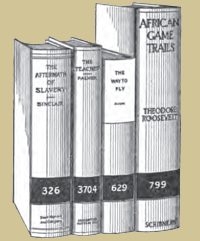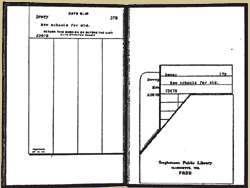Mechanical preparation of books
CUT all necessary leaves of new books with a dull-edged paper-knife.
To open a new book properly, hold the book with its back on a hard smooth surface, press the front cover down until it touches the table, then from back cover, holding the leaves in one hand, press open a few at the back, then at the front, alternately, pressing down firmly until all have been so treated. Opening suddenly or violently will sometimes break the binding or loosen the leaves.
White or light-colored books and all children's books may be protected from soil and water by two coats of white shellac (Cat. no. 1390) and after drying, a final coat of floor wax well rubbed in. Any good floor wax will answer.
Marking class numbers on the backs of books with white ink, if properly done, is more satisfactory, durable, and attractive than paper labels. No matter how much care is used in sticking on paper labels, they will come off.
A neat and attractive method of marking books consists of painting with shellac mixed with a small amount of powdered lampblack, a spot on the back of the book the size of an ordinary label, one and one- half inches from the bottom, using a stencil to keep the size and position uniform. A quicker way is to paint a straight band an inch wide at a uniform distance from the bottom of the book. When dry, mark the class number with Davids' white letterine ( Cat. no. 1339), dry and coat with white shellac to protect the marking. Lampblack may be had of any local painter.
 If necessary to change the marks for any reason, paint over with another coat of shellac and lampblack.
If necessary to change the marks for any reason, paint over with another coat of shellac and lampblack.
Judge's quill pen (Cat. no. 1814) works well with white ink, and should be kept clean while in use. If the ink becomes thick, thin with water.
Example of Marking.
Preparation of books for circulation
Each book should have a book card or charging card (Cat. no. 1150 or 1152), upon which is written the author, title, class number, and accession number. This card is placed in a pocket, preferably at the back of the book.
A form of pocket which is very satisfactory is one with a slanting opening at the top (Cat. no. 1173L), and is pasted on the inside back cover of the book. These may be printed with the name of the library or stamped with a rubber stamp of ownership. Also, if desired, they may be printed with very simple library rules. However, specific information as to amount of fine, as to amount of fine, number of books issued to each borrower, hours open, etc., may better be printed on a bookmark, as these items are likely to change from time to time.
Some librarians prefer to place the pocket on the inside front cover of the book. This hinders the use of a bookplate if one should be desired at a future time, as the usual location for a bookplate is the inside front cover. Pockets designed for the front of the book are shown in Library Bureau "Library supplies" catalog.
 Position of date slip, pocket, and book card, showing
lettering on each —
Position of date slip, pocket, and book card, showing
lettering on each —
The book card in the cut (Cat. no. 1150) shows where the various items should be written, and the repetition of these items on the pocket will insure accuracy in discharging books. On the opposite flyleaf facing the pocket is placed a date slip (Cat. no. 1140). The date stamped on this slip is for the information of the reader, and is also useful in discharging books.
Seven-day labels (Cat. no. 1333) are used in new
or popular books to speed their return, in order that
other borrowers may have an opportunity to read
them. They are usually pasted above or below the
pocket.